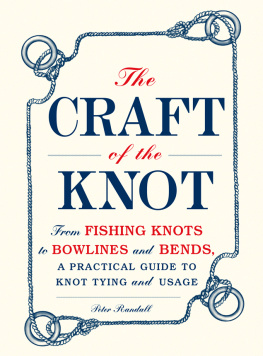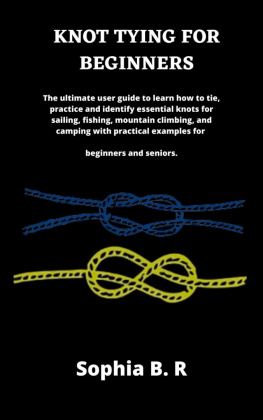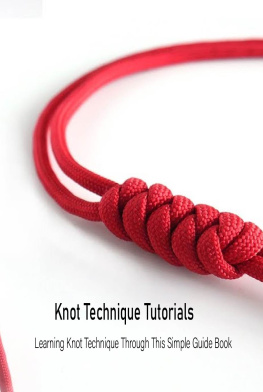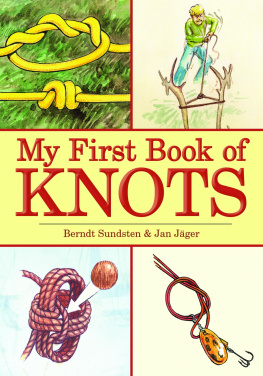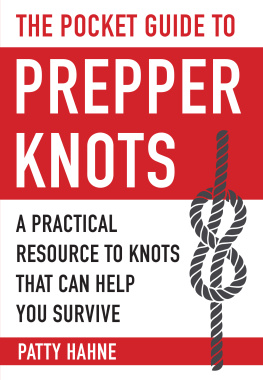Introduction
T HE H ISTORY OF K NOTS
Its said that long ago the ancient kingdom of Phrygia was without a king. Desperate, the kingdoms elders swore that they would take as their ruler the next man to pass through the city gates. It so happened that immediately afterward, a peasant named Gordias drove his ox cart through the gates and was duly hailed by the elders as the new Phrygian king.
Gordiass son, Midas, tethered his fathers ox cart to a post near the citys gate. In order that people might remember their rulers humble origins, Midas tied the cart to the post with a special knot, one that could not be undone by ordinary means. Pulling on it merely made it tighter and firmer. People from far and wide came to marvel at the Gordian Knot, which no one could untie.
Finally, Alexander the Great, the Greek conqueror of Persia, arrived in the city and was shown the knot. Never one to withstand a challenge, Alexander declared that he could undo the Gordian Knot. And while the people of Phrygia watched in amazementand shockAlexander drew his sword and sliced through the knot with a single stroke. To this day, when someone has unraveled a particularly difficult problem in a surprising way, we say that they have cut the Gordian Knot.
P REHISTORIC O RIGINS
The story of Alexanders feat shows how knots have been woven into the fabric of our history and mythology. Apart from myth, knots have been part of human history as far back as we knowpossibly as long ago as 2.5 million years. We can make some educated guesses about the origins of knots and cordage based on the scant traces left of early human lives as well as what we know about that environment, what materials were at hand, and what inspiration was available from the surroundings.
Both plant and animal materials were available to prehistoric humans to be used as cordage. Numerous plants are made of strong fibers that provide structural strength. Some plantssuch as vinescan be used as cordage without any preparation at all. Additionally, early hunters had a wide choice of animals as a resource. Hides were cut into thin strips as a ready source of tying materials. Tendons were especially strong. And many other parts of animals have been used throughout the ages.
Early humans must have been inspired to tie their first knots by what they saw around them. Spider webs, bird nests, and even the complex structures of many plants may have given them a hint as to how to proceed. Occasionally small game would become tangled in undergrowth, and even fish would become ensnared in underwater growth. Nature can be a great teacher of what cordage can accomplish.
Some occurrences in the environment probably helped early knot tyers to improve the use of cordage. Perhaps they noticed that when they pulled some twigs apart, two of them would bind if their ends happened to have been bent and overlapped. Plants sometimes grow in Half Hitches around one another. Overhand Knots seem to form spontaneously in cordlike materials. You have, no doubt, seen knots suddenly appear in garden hoses and electrical cords. So, it is not a stretch to imagine that Overhand Knots, Half Hitches, and various twists in materials could have been tied on purpose in an attempt to duplicate nature.
H ISTORICAL E VIDENCE
Ancient artifacts tell us a wide-ranging story about our past. This story has its gaps, especially when it comes to the history of knotting. That is not surprising when you consider that the natural materials cordage was made from decay in almost all environments. However, the surviving samples provide direct evidence of early humans incorporating the technology of knotting into how they lived.
Some of the most direct evidence we have comes from a discovery made by hikers on the Austrian-Italian border in 1991. They came across the mummified body of a human male; carbon dating established that he had died more than 5,300 years before. tzi the iceman, as he has become known, carried with him various objects that showed cords and knotting played an important role in his life. His knife was hung by his side by a knotted cord; his sandals were held together with knots (he also had a cloak made of woven grass), as well as his cap, which was secured to his chin with a knotted strap. A bow that he carried must have been strung using knots.
Even when artifacts have no surviving cordage with them, the items can still give us clues that they were used with cordage. For instance, a small decorative jewelry-like item that has a hole cut into it was probably suspended from a cord. Some of the artifacts even show wear at the place where the string would have been tied. Other items have deep indentations that would have needed knotting to hold them in place. Spears and hatchets were shaped to facilitate binding to a shaft. Pottery fragments show indentations of three-strand rope and a surprising variety of decorative knotting. Early artwork in both paintings and carvings also depict knotting.
In more recent times, of course, we have actual pieces of knotting to reveal glimpses of our past. These samples show uses in just about all aspects of life, from decorative objects to hunting-and-gathering instruments. Many cultures have shown ingenuity in making cordage with the materials available; others have truly taken knot tying to an art form.
S IGNS OF P ROGRESS
Civilization has come a long way since humans first coaxed fish out of a stream with a woven tangle of vines, but we didnt do it all at once. We accomplished it in many stages, with a steady application of knotting all the way. Whenever humans have learned something new, they have updated the technology of cordage and knotting along with it. For many early users of knots and cordage, being able to tie a line to a fishing hook or lash a spear to a shaft meant being able to feed their family. Being able to make lashings meant building structures to protect the family from the elements. It meant survival. Knot tying was not an optional activityit was a way of life. Humankind has improved methods for hunting, warring, and surviving the elements, and increased knotting skills went hand in hand with these advances. When it came time to sail the seas, domesticate cattle, and even keep track of numbers and dates, knots continued to be used in new ways.
New cultures, religions, and technologies brought on many changes, and humans learned various new professions. Clothes and blankets take considerable time to tie and weave. When the industrial revolution came along, the first machines made were for tying knots and weaving. Rope had been mass-produced long before then. Through all these changes, few endeavors were taken up without laying in a major supply of cordage.
The existence of knots meant more than just function to our ancestors. As early humans learned to apply symbolism, knots played a key role. Even superstitious beliefs became attached to knots, thereby giving them more than just a symbolic role.
As humankinds use of symbolism and communication developed, knots took on new meaning by way of representation. As people learned to count days, they counted them with knots on a string.

